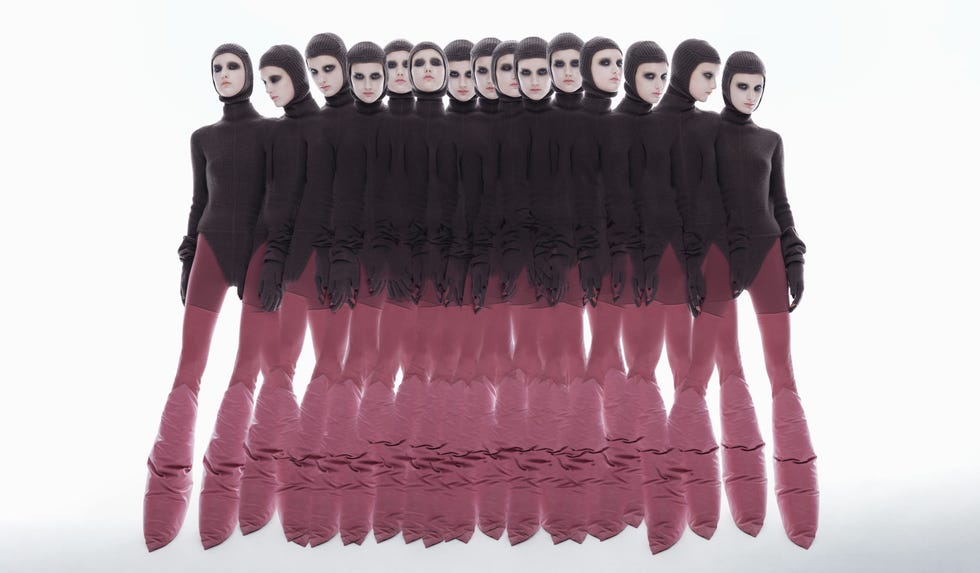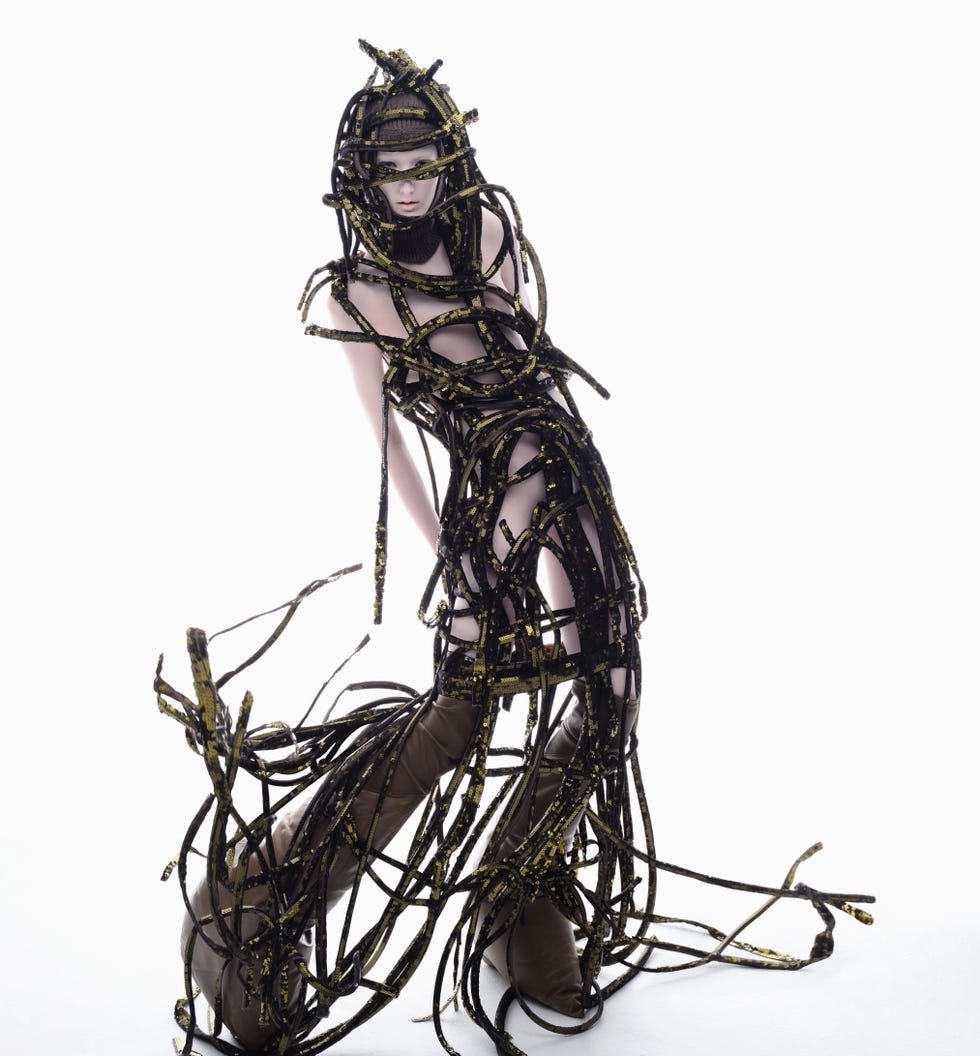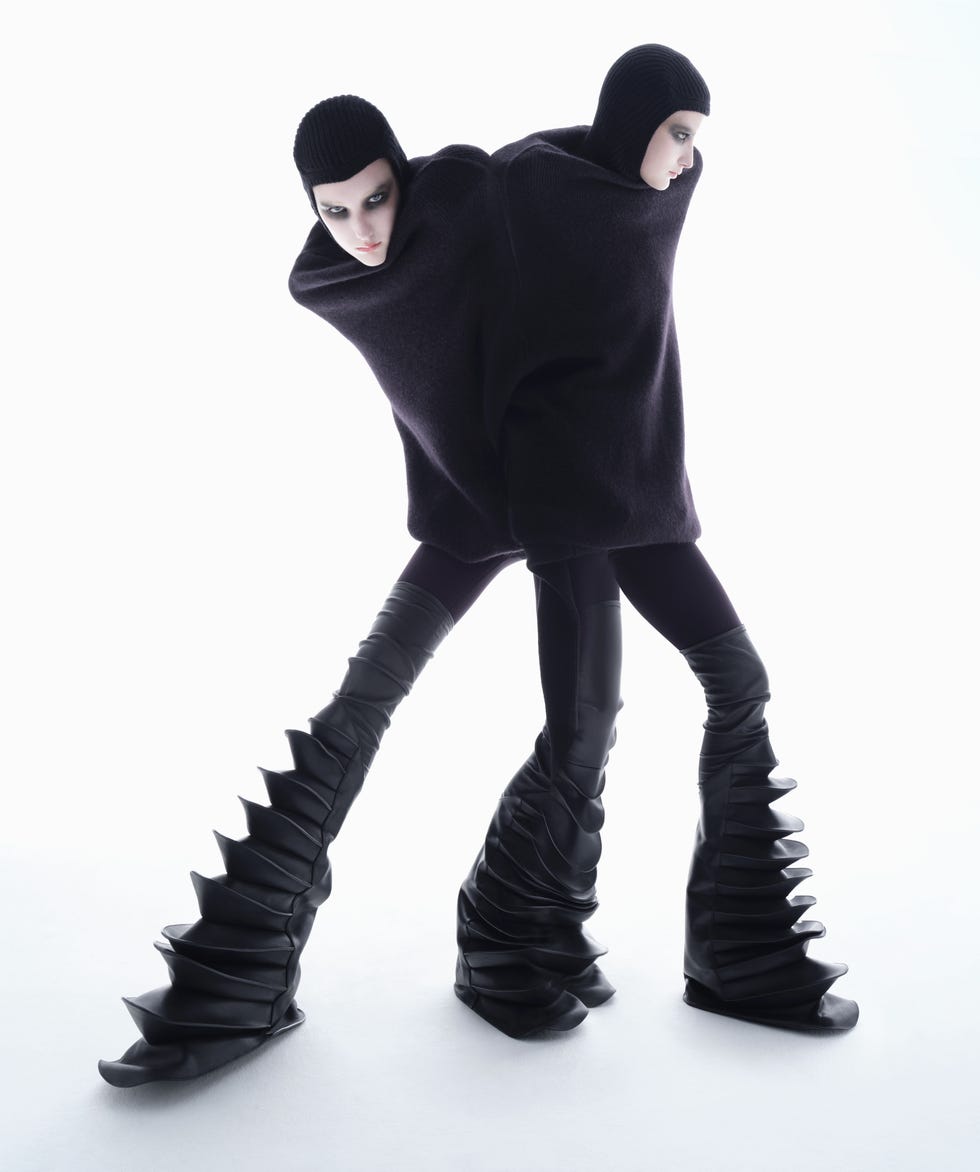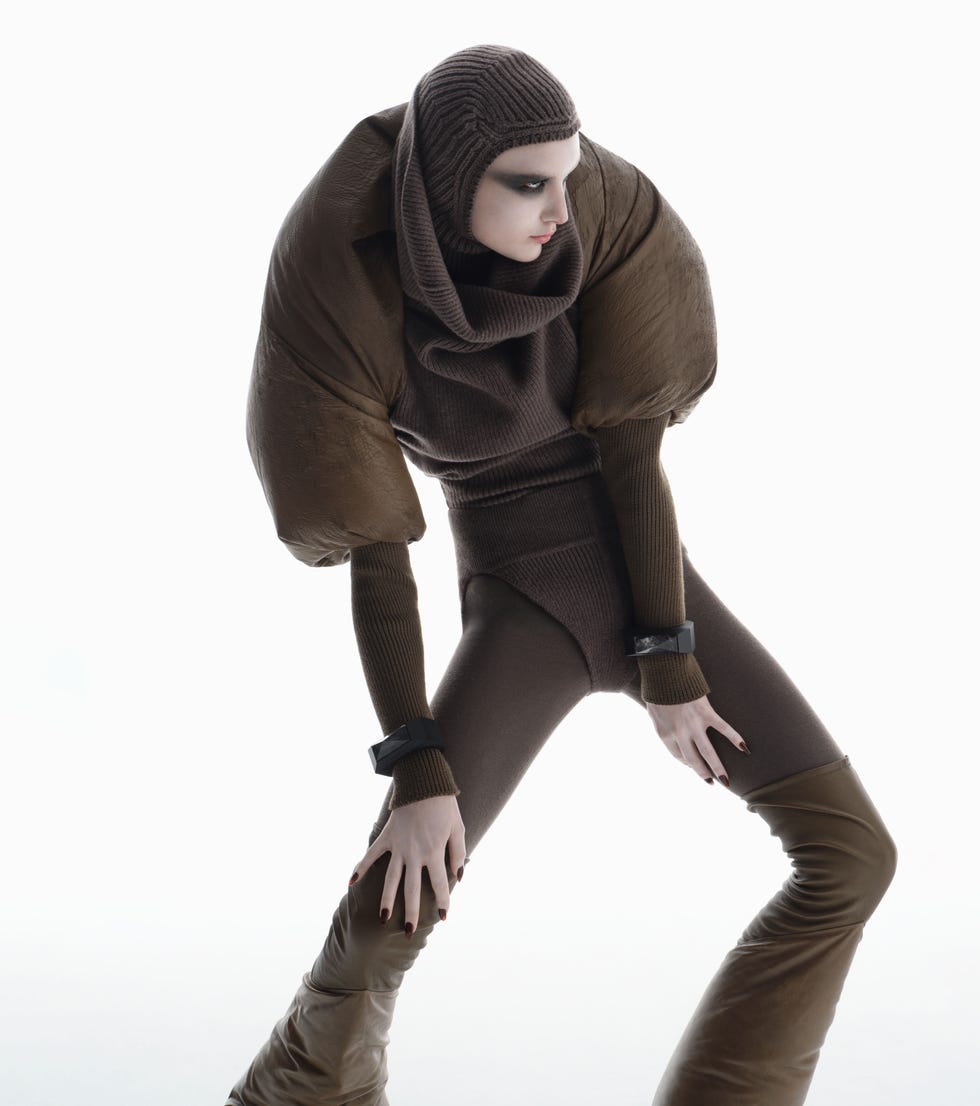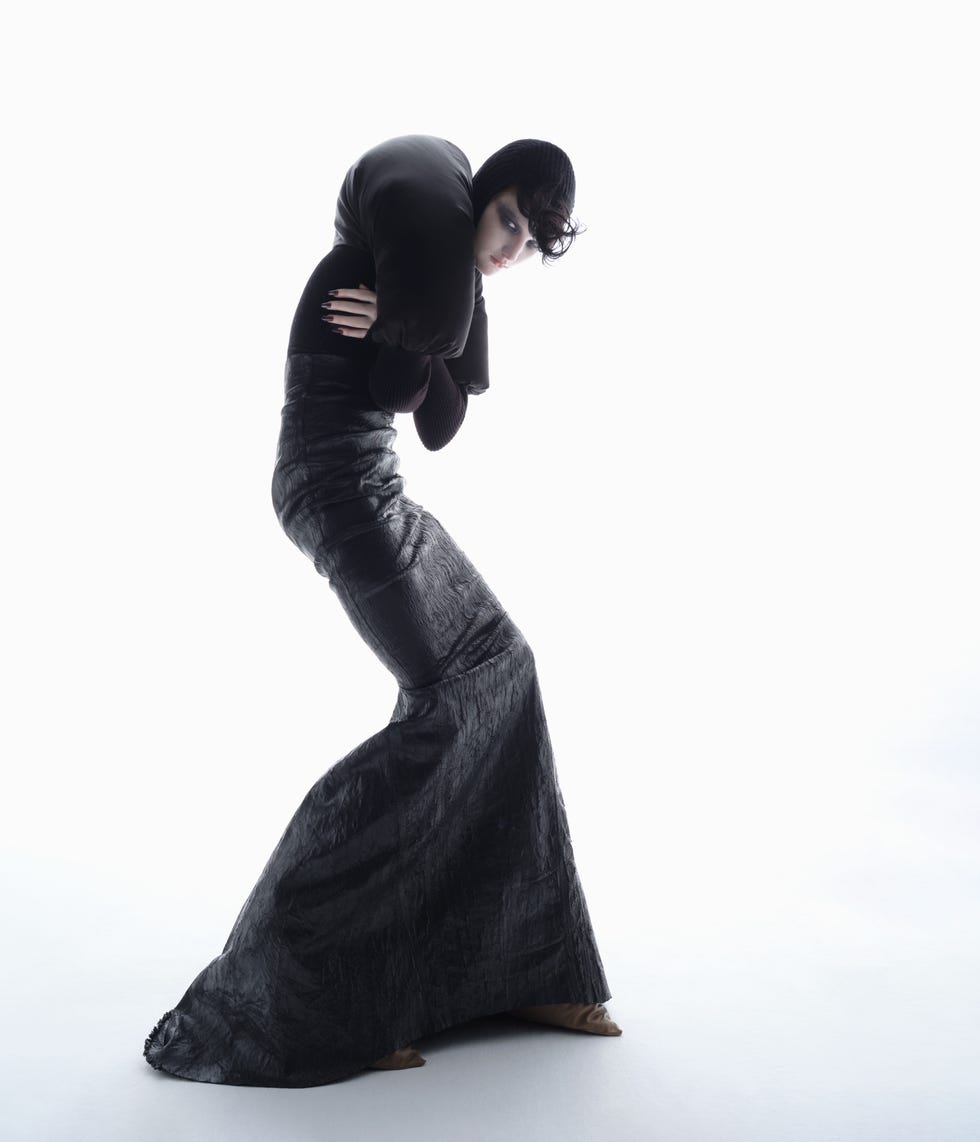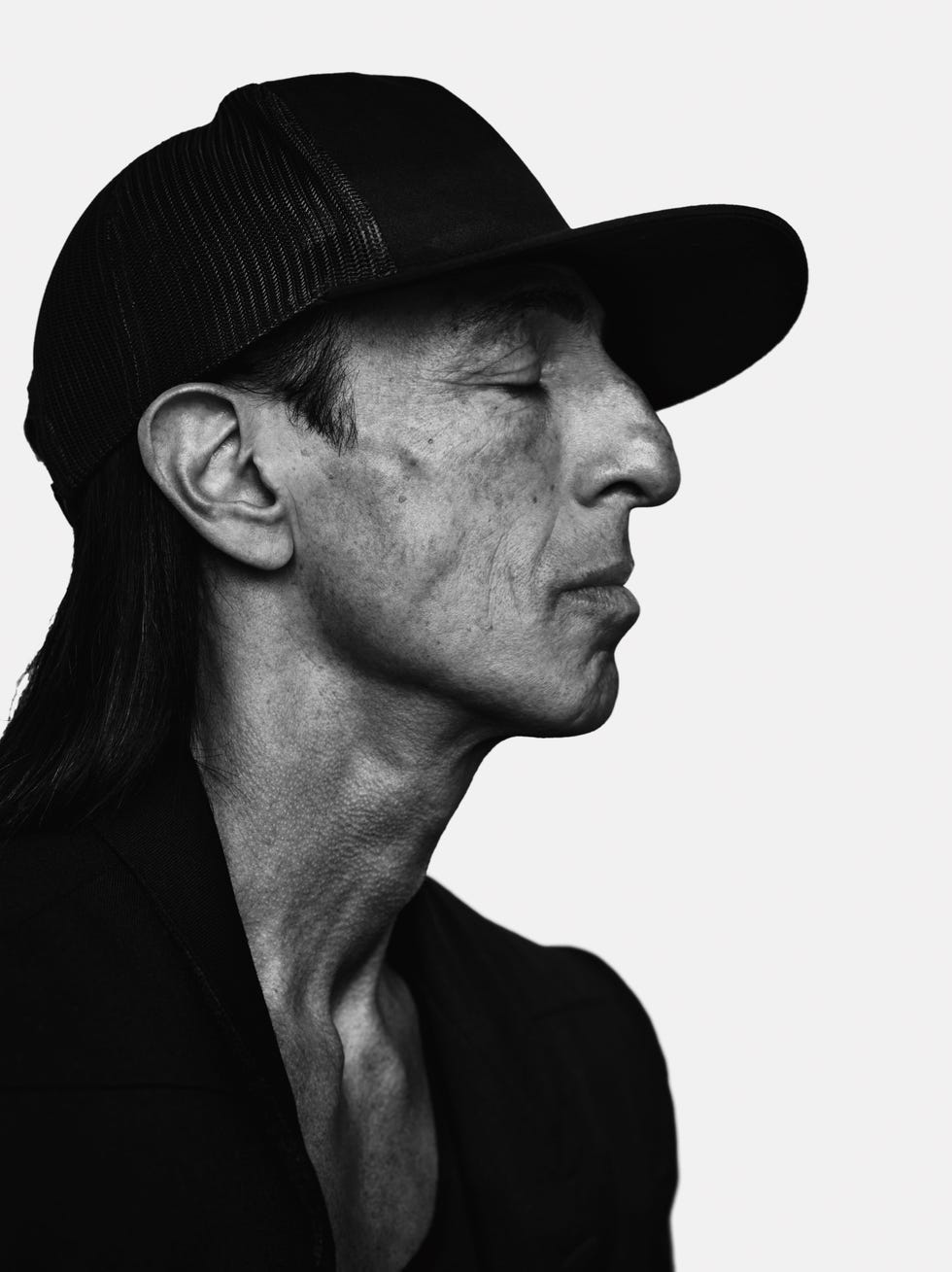
You can’t go home again, but Rick Owens tried to. A few years ago, he returned to Porterville, California, the town where he grew up, and for fall 2024, he brought Porterville to his current home of Paris—as in, he literally invited show guests over to his house, a 19th-century townhome-meets-Brutalist bulwark that once served as the headquarters of the French Socialist party.
The fashion was, as it always is at a Rick Owens show, a melding of the sublime and the perverse: sculptural, wirelike tangles of cotton voile and mesh; spiky, reptilian boots. Named for his hometown, the collection “was kind of a celebration,” he says in his California inflection, his syllables flat and dry as the Mojave Desert. “I was able to create the world I was yearning for in Porterville. It might not have worked out, but it did.”
That might be the thesis statement of Owens’s career. In Porterville, which he portrays as Main Street, USA, he felt “oppressed and afraid and ashamed.” There was his queerness (he identifies as bisexual), his self-described “sissiness,” his general quality of not belonging. One portal out was Frank Frazetta, whose fantasy art decorated the paperbacks his father read to him, and featured “the most glamorous, heroic, sexy-looking people who were pursuing a next level of living,” he remembers. Another was Catholic school, where he learned that everyone had a higher purpose, a concept that intrigued him. “It was all about studying these creatures wearing long robes that dragged on the ground,” he says, “saints and nuns and priests pursuing a higher spiritual level.”
Though the opportunities for transcendence were scarce, they were all the more powerful for it. “If I had been living on the Upper East Side, being taken to museums every weekend, I don’t know if I would’ve developed that thirst and rage,” he says. With this collection, “I was condemning Porterville for being such an oppressive place, but acknowledging that that kind of tension is what makes somebody like me do stuff. The way that my father, who I’ve always mentioned was a bully who taught me fear and shame, also taught me about Japanese art and opera. We were extremely affectionate friends, but mortal enemies at the same time. The fear and the shame probably worked out….It motivated me.”
From there, Owens’s life story almost calls out for jump cuts: Twentysomething Owens crashing on a pile of blankets at a friend’s warehouse studio in Culver City. When he stayed out late, he’d shimmy up the emergency stairs and get in through a window near the roof. (“I’d be out in the rain, in this black velvet cape with full makeup,” he says. “That was very dramatic.”) Starting his brand in L.A. in 1994—not building an archive the way young designers do now, because he wasn’t thinking about his legacy, but simply about selling clothes. Meeting his wife, Michèle Lamy, whom he calls both “the chicest mind that I’ve ever come up against” and “a primitive little beast who takes what she wants and leaves wreckage behind her.” They’ve been married for 18 years, which he credits to the opposites-
attract tension between his rationality and her emotionality. Getting sober at 40, with Lamy’s encouragement. His first show in Paris in 2003, a breath of fresh air on fashion’s most exclusive calendar.
Today, Owens is one of the most recognizable designers in the world and a mainstay at Paris Fashion Week, despite the fact that the city once felt, he says, as far away as the moon. He’s 22 years sober, a fitness fanatic who blasts Kiss in the gym (he’s drawn to their “big happy dumb-dog jubilance”) and a taker of daily naps. In a frantic industry, he’s the most relaxed-seeming designer around, even if you sense that image belies the tough-as-nails core that got him here. He doesn’t seem swayed by what every other designer is up to, though he does pay attention to it. The only person he’s in competition with is himself, but you sense that all the previous Ricks follow him around. Like the one he was when he was still drinking to the point of what he calls “temporary suicide.” Part of the drinking was “building up the courage to present myself to the world and insist that I had something worth looking at. And that almost takes arrogance,” he says. Looking back, he thinks, “‘How did I have the nerve to think that everybody had to see what I was doing?’ Bless my heart.” When he finally quit, Lamy had nurses stay with him and administer sedatives so he didn’t hyperventilate to death. “I thought, ‘Oh, it feels so much better not to have a hangover.’” (Coincidentally, right after he stopped drinking, his career took off: He signed a deal to manufacture his line in Italy and get distribution.) The fitness began as a counterbalance to the drinking. “It was mainly about vanity, not health, I’m embarrassed to say. Or am I? I’m not sure I am.”
Now he’s reached a level he could never have dreamed of, where he simultaneously feels accessible and niche. Collaborations with Adidas and Converse, among others, have brought him to the masses, but he retains the independence that draws superfans. He attributes this following to his belief that “I don’t think designers are allowed to be that honest. Most of them have to work for a company, and they have a lot of voices to answer to. And so you get the sense that there’s a committee there.…Do I really want to buy a bag from a company that I know pays celebrities to be in their front row? Are those the values that I want to align myself with?”
He jokes that “on my tombstone, I will be recognized for sneakers. And that’s not where I wanted to go at all. My sneakers were a parody at the beginning. I could not find anything ridiculous or exaggerated enough, because I thought sneakers were the dreariest, most suburban thing. But I started going to the gym and I needed something flamboyant and theatrical to wear, so I made the most exaggerated monster truck sneakers I could think of. I’m not complaining at all, but it’s just funny how that’s going to be my epitaph.”
With his 30th anniversary this year, Owens has been thinking more about the past. And not just his days in Porterville. Last year, for his birthday, he returned to another place that has significant meaning for him: Mexico, which his mother, Concepción, left to elope with his American father, and where he still has many relatives. He has been exploring “my Mexicanness,” something that he had not identified with as strongly growing up. And he’s been thinking fondly of his late mother, who loved to sew and may have been part of the reason he got into fashion.
Now, as he prepares for a career retrospective next year at Paris’s Palais Galliera—he is the only designer besides Martin Margiela and Azzedine Alaïa to have received the honor during his lifetime—he has been thinking about what a legacy might mean. “Is that leaving a foundation? Leaving an archive? Leaving a mood? I feel like I’m part of a long line of people who have maybe gently influenced aesthetics,” he says. “I want to be a resource for people to turn to when they feel like they don’t see themselves reflected in contemporary aesthetics that are very narrow and condemning and sometimes cruel.” So he takes joy in bringing “a gleeful depravity” to his runways. (He likes using pentagrams because “it’s my little way of heckling conservatives.”)
The world can feel more like Owens’s vision of Porterville every day, shunning anyone different and calcifying the idea of beauty into Ozempic-chiseled, Botoxed sameness. Owens wants to be an alternative to that reality. After all, provocative art “saved me when I was young,” he says. “I want to be that guy for people.”
Hair by Pierpaolo Lai for Dyson; makeup by Stephane Marais at Hortense Bernardin; manicure by Elsa Durrens at WSM; casting by Shaun Beyen at Plus Three Two; model: Addison Soens at Ford Models; produced by Louis2.
This article appears in the September 2024 issue of ELLE.

Véronique Hyland is ELLE’s Fashion Features Director and the author of the book Dress Code, which was selected as one of The New Yorker’s Best Books of the Year. Her writing has previously appeared in The New York Times Magazine, The New Yorker, W, New York magazine, Harper’s Bazaar, and Condé Nast Traveler.
 Print
Print
